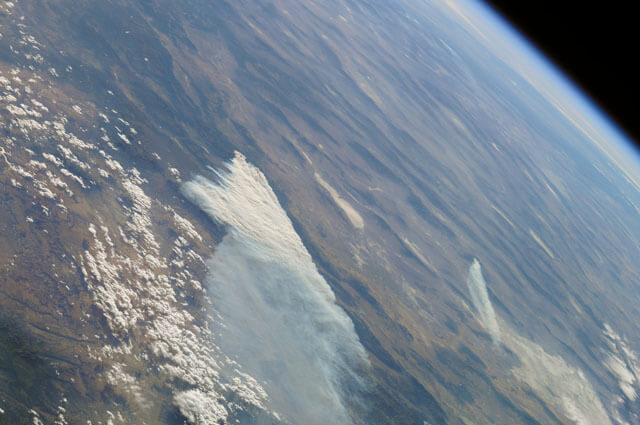Stratospheric Aerosol Injection – Climate change is real! It was the early 19th century when we were able to detect climate change and the first sign of global warming. With time climate change has resulted in rising maximum and minimum global temperatures, increasing sea levels and ocean temperatures, abundant precipitation, and contracting glaciers. Many environment-friendly initiatives have also been suggested and employed to mitigate climate change. A study published in 2018 in the journal Environmental Research Letters emphasized the SAI (Stratospheric Aerosol Injection) technique to create a reflective barrier against sunlight. This “still unproven” technique might be a possible solution to controlling environmental change.
What is Stratospheric Aerosol Injection?
Stratospheric Aerosol Injection is a technique of solar radiation management in which sunlight is reflected into space before it is passed through the atmospheric layers and hence not contributing to the rise in Earth’s temperature. This is so far the best Geoengineering technique with the highest cooling potential.
Aerosols are tiny particles suspended in the atmosphere. These minute particles can successfully scatter and absorb the sunlight. Depending upon the source, reflective aerosols are introduced in three ways. These are discussed below.
Different Types of Aerosols
Based on the constituents, aerosols are of numerous types.
Volcanic Aerosol
A significant portion of aerosols in the atmosphere is from volcanic eruptions. A large amount of sulfur dioxide (SO2), hydrochloric acid (HCL), and ash are released into the atmosphere from volcanos. With time sulfur dioxide gas is converted to droplets of sulfuric acid (H2SO4) in the stratosphere. Upon condensation, these droplets become aerosols that are spread over the globe with the help of winds. These aerosols stay in the atmosphere for about two years, reflecting sunlight and making the Earth cool.
Desert Dust Aerosols
Particles that stream out into the atmosphere from the desert are another type of reflective aerosol. The study from Lidar In-space Technology Experiment (LITE) in 1994 proved the presence of desert dust particles in the lower portion of the atmosphere. Desert dust aerosols are also called mineral aerosols because of their composition. The minerals stand good in absorbing and reflecting the light. These particles are suspended in the atmosphere as long as the storm clouds do not distort them.
Human-Made Aerosols
The industrial revolution has substantially contributed to atmospheric aerosols. Increased human activities of burning coal and oil have raised the level of sulfate aerosols in the atmosphere. sulfate aerosols have a lifetime of approximately3-5 days in the atmosphere.
Suggested Reading List–
- Environmental DNA (eDNA) – an effective biodiversity monitoring tool
- Blue Flag Certification – An environmental award for beaches, marinas, and boating tourism operators
Concerns of Stratospheric Aerosol Injection
As this technique is not proven yet it is deemed hypothetical or fictitious. To answer why it is attached to controversies, we need to understand – how does stratospheric aerosol injection works? The basic idea of aerosol injection is to send aircraft to sprinkle tiny sulfate particles into the stratosphere, the second layer of the atmosphere below the mesosphere. The height that we are referring to here is more than 60,000 feet from the Earth.
The veil created so will shield the earth from sunlight to diminish the Earth’s temperature. As explained above this method imitates what large volcanoes (e.g. the 1991 eruption of Mount Pinatubo, Philippines) would do. According to U.S. Geological Survey, the cataclysmic event of Mount Pinatubo resulted in a global temperature drop of nearly 1°F. This is to be noted that the temperature drop was short-lived (for a few years) as the sulfate particulates dropped to Earth. Adding to the controversy, a 2017 study published in Nature journal discusses the impact of Stratospheric Aerosol Injection on tropical cyclone frequency.
Current Events From Science And Technology–
- 12 Rare Quadruple Quasars Discovered
- Muon g-2 Experiment At Fermilab
- Nora Al Matrooshi – First Arab Woman Astronaut
- NASA’s Chandra X-ray Observatory detected X-rays from Uranus
- Carnivac-Cov: First COVID-19 Vaccine For Animals
Cost of Stratospheric Aerosol Injection
To fulfill the requirement of the Stratospheric Aerosol Geoengineering technique right now we do not have the powerful aircraft to attain such a high altitude that too with enormous payload. First of all, some special kind of aircraft dubbed as SAI Lofters needs to be developed to match the requirements of the project.
The team has estimated the development cost for such an airframe to be $2 billion and $350 million to modify existing engines. This is inexpensive compared to other techniques proposed or employed.
Conclusion
Solar geoengineering techniques are considered fast and cheap but relatively imperfect. The researchers have coordinated with a few aerospace and engine companies and the timeline for this hypothetical deployment program is set 15 years from the research publication. Scientists have also pointed out some major concerns related to Stratospheric Aerosol Injection like extreme weather in some parts of the globe, the possibility of droughts hampering crop yields.
That is not all, increasing carbon dioxide emissions and the effect of global warming have not been addressed in the study. Serious efforts from intellectuals all over the world are required to make solar geoengineering techniques such as Stratospheric Aerosol Scattering a viable solution to mitigate climate change.
Stratospheric Aerosol Injection FAQs
The Stratospheric Aerosol Injection is a geoengineering technique that is considered to help fight the global warming of Earth in a long run.
Mainly the aerosol particle consists of sulfuric acid and water.
The Stratospheric Aerosol Scattering technique is still an unproven and hypothetical technique. It might cause droughts or extreme weather also, it doesn’t address the issue of rising carbon dioxide emissions.
As per the sources referred to in this article, the development of design and deployment might take 15 years from now.
The total cost for this effort is going to be $3.5 billion along with an annual maintenance cost of $2.25 billion per year. This is still an inexpensive program.
